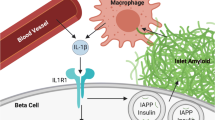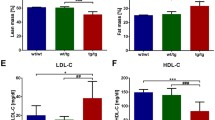Abstract
Background
Islet amyloid polypeptide (IAPP) is deposited as amyloid in the islets of Langerhans in type 2 diabetes. The mechanism behind the formation of the cytotoxic fibrils is unknown. Islet amyloid develops in a mouse IAPP null mouse strain that expresses human IAPP (+hIAPP/−mIAPP) after 9 months on a high-fat diet. Herein we investigate the effect that individual free fatty acids (FFAs) exert on formation of amyloid-like fibrils from synthetic IAPP and the effects of FFAs on IAPP polymerization in +hIAPP/−mIAPP islets cultivated in vitro.
Materials and Methods
In the study myristic acid, palmitic acid, stearic acid, oleic acid, and linoleic acid were used together with albumin. Thioflavin T (Th T) assay was used for quantification of amyloid-like fibrils. Islets were isolated from the + hIAPP/−mIAPP transgenic strain and cultured in the presence of the FFAs for 2 days. Immunoelectron microscopy was used for evaluation.
Results
The Th T assay showed that all studied FFAs potentiated fibril formation but that myristic acid revealed the highest capacity. In some cells from cultured islets, intragranular aggregates were present. These aggregates had a filamentous appearance and labeled with antibodies against IAPP. In some cells cultured in the presence of linoleic acid, large amounts of intracellular amyloid were present. Earlier, this has not been observed after such a short incubation period.
Conclusions
Our studies suggest that FFAs can potentiate amyloid formation in vitro, probably without being integrated in the fibril. Cultivation of +hIAPP/−mIAPP transgenic mouse islets with FFAs results in altered morphology of the secretory granules with appearance of IAPP-immunoreactive fibrillar material. We suggest that such fibrillar material may seed extracellular amyloid formation after exocytosis.



Similar content being viewed by others
References
Bell ET. (1952) Hyalinization of the islets of Langerhans in diabetes mellitus. Diabetes 1: 341–344.
Westermark P. (1995) Islet amyloid polypeptide and amyloid in the islets of Langerhans. In Leslie RDG, Robbins D (eds). Diabetes: Clinical Science in Practice. Cambridge: Cambridge University Press; pp. 189–199.
Westermark P, Wernstedt C, Wilander E, Sletten K. (1986) A novel peptide in the calcitonin gene related peptide family as an amyloid fibril protein in the endocrine pancreas. Biochem. Biophys. Res. Commun. 140: 827–831.
Westermark P, Wernstedt C, Wilander E, et al. (1987) Amyloid fibrils in human insulinoma and islets of Langerhans of the diabetic cat are derived from a neuropeptide-like protein also present in normal islet cells. Proc. Natl. Acad. Sci. U. S. A. 84: 3881–3885.
Cooper GJ, Willis AC, Clark A, et al. (1987) Purification and characterization of a peptide from amyloid-rich pancreases of type 2 diabetic patients. Proc. Natl. Acad. Sci. U. S. A. 84: 8628–8632.
Kahn SE, Andrikopoulos S, Verchere CB. (1999) Islet amyloid: a long-recognized but underappreciated pathological feature of type 2 diabetes. Diabetes 48: 241–253.
Höppener JW, Ahren B, Lips CJ. (2000) Islet amyloid and type 2 diabetes mellitus. N. Engl. J. Med. 10: 411–419.
Gebre-Medhin S, Mulder H, Pekny M, et al. (1998) Increased insulin secretion and glucose tolerance in mice lacking islet amyloid polypeptide (amylin). Biochem. Biophys. Res. Commun. 250: 271–277.
O’Brien TD, Wagner JD, Litwak KN, et al. (1996) Islet amyloid and islet amyloid polypeptide in cynomolgus macaques (Macaca fascicularis): an animal model of human non-insulindependent diabetes mellitus. Vet. Pathol. 33: 479–485.
Betsholtz C, Svensson V, Rorsman F, et al. (1989) Islet amyloid polypeptide (IAPP):cDNA cloning and identification of an amyloidogenic region associated with the species-specific occurrence of age-related diabetes mellitus. Exp. Cell Res. 183: 484–493.
D’Alessio DA, Verchere CB, Kahn SE, et al. (1994) Pancreatic expression and secretion of human islet amyloid polypeptide in a transgenic mouse. Diabetes 43: 1457–1461.
De Koning EJ, Höppener JW, Oosterwijk C, et al. (1993) Localisation of islet amyloid polypeptide (IAPP) in pancreatic islets of transgenic mice expressing the human or rat IAPP gene. Biochem. Soc. Trans. 21: 26S
Fox N, Schrementi J, Nishi M, et al. (1993) Human islet amyloid polypeptide transgenic mice as a model of non-insulin-dependent diabetes mellitus (NIDDM). FEBS Lett. 323: 40–44.
Yagui K, Yamaguchi T, Kanatsuka A, et al. (1995) Formation of islet amyloid fibrils in beta-secretory granules of transgenic mice expressing human islet amyloid polypeptide/amylin. Eur. J. Endocrinol. 132: 487–496.
Verchere CB, D’Alessio DA, Palmiter RD, et al. (1996) Islet amyloid formation associated with hyperglycemia in transgenic mice with pancreatic beta cell expression of human islet amyloid polypeptide. Proc. Natl. Acad. Sci. U.S.A. 93: 3492–3496.
Janson J, Soeller WC, Roche PC, et al. (1996) Spontaneous diabetes mellitus in transgenic mice expressing human islet amyloid polypeptide. Proc. Natl. Acad. Sci. U.S.A. 93: 7283–7288.
Tsunehara CH, Leonetti DL, Fujimoto WY. (1990) Diet of second-generation Japanese-American men with and without non-insulin-dependent diabetes. Am. J. Clin. Nutr. 52: 731–738.
Lee SK, Opara EC, Surwit RS, et al. (1998) Defective glucose-stimulated insulin release from perifused islets of C57BL/6J mice. Pancreas 11: 206–211.
Skelly RH, Bollheimer LC, Wicksteed BL, et al. (1998) A distinct difference in the metabolic stimulus-response coupling pathways for regulating proinsulin biosynthesis and insulin secretion that lies at the level of a requirement for fatty acyl moieties. Biochem. J. 331: 553–561.
Zhou Y-P, Grill VE. (1994) Long-term exposure of rat pancreatic islets to fatty acids inhibits glucose-induced insulin secretion and biosynthesis through a glucose fatty acid cycle. J. Clin. Invest. 93: 870–876.
Furukawa H, Carroll RJ, Swift HH, Steiner DF. (1999) Long-term elevation of free fatty acids leads to delayed processing of proinsulin and prohormone convertases 2 and 3 in the pancreatic beta-cell line MIN6. Diabetes 48: 1395–1401.
Westermark GT, Gebre-Medhin S, Steiner DF, Westermark P. (2000) Islet amyloid development in a mouse strain lacking endogenous islet amyloid polypeptide (IAPP) but expressing human IAPP. Mol. Med. 6: 998–1007.
Westermark GT, Leckström A, Ma Z, Westermark P. (1998) Increased release of IAPP in response to long-term high fat intake in mice. Horm. Metab. Res. 30: 256–258.
Westermark P, Li ZC, Westermark GT, et al. (1996) Effects of beta cell granule components on human islet amyloid polypeptide fibril formation. FEBS Lett. 379: 203–206.
Janciauskiene S, Eriksson S, Carlemalm E, Ahrén B. (1997) B cell granule peptides affect human islet amyloid polypeptide (IAPP) fibril formation in vitro. Biochem. Biophys. Res. Commun. 236: 580–585.
Kudva YC, Mueske C, Butler PC, Eberhardt NL. (1998) A novel assay in vitro of human islet amyloid polypeptide amyloidogenesis and effects of insulin secretory vesicle peptides on amyloid formation. Biochem. J. 331: 809–813.
Wilson DM, Binder LI. (1997) Free fatty acids stimulate the polymerization of tau and amyloid beta peptides. In vitro evidence for a common effector of pathogenesis in Alzheimer’s disease. Am. J. Pathol. 150: 2181–2195.
Puchtler H, Sweat F, Levine M. (1962) On the binding of Congo red by amyloid. J. Histochem. Cytochem. 10: 355–364.
LeVine H 3rd. (1993) Thioflavine T interaction with synthetic Alzheimer’s disease β-amyloid peptides: detection of amyloid aggregation in solution. Protein Sci. 2: 404–410.
LeVine H 3rd. (1999) Quantification of beta-sheet amyloid fibril structures with thioflavin T. Meth. Enzymol. 309: 274–284.
Christmanson L, Betsholtz C, Leckström A, et al. (1993) Islet amyloid polypeptide in the rabbit and European hare: studies on its relationship to amyloidogenesis. Diabetologia 36: 183–188.
Rochet JC, Lansbury PT Jr. (2000) Amyloid fibrillogenesis: themes and variations. Curr. Opin. Struct. Biol. 10: 60–68.
Prentki M, Vischer S, Glennon MC, et al. (1992) Malonyl-CoA and long chain acyl-CoA esters as metabolic coupling factors in nutrient-induced insulin secretion. J. Biol. Chem. 267: 5802–5810.
Brodersen R, Andersen S, Vorum H, et al. (1990) Multiple fatty acid binding to albumin in human blood plasma. Eur. J. Biochem. 30: 343–349.
Wisniewski T, Frangione B. (1992) Apolipoprotein E: a pathological chaperone protein in patients with cerebral and systemic amyloid. Neurosci. Lett. 135: 235–238.
Couce M, Kane LA, O’Brien TD, et al. (1996) Treatment with growth hormone and dexamethasone in mice transgenic for human islet amyloid polypeptide causes islet amyloidosis and β-cell dysfunction. Diabetes 45: 1094–1101.
MacArthur DL, de Koning EJ, Verbeek JS, et al. (1999) Amyloid fibril formation is progressive and correlates with beta-cell secretion in transgenic mouse isolated islets. Diabetologia 42: 1219–1227.
Westermark P. (1973) Fine structure of islets of Langerhans in insular amyloidosis. Virchows Arch. A 359: 1–18.
O’Brien TD, Butler AE, Roche PC, et al. (1994) Islet amyloid polypeptide in human insulinomas. Evidence for intracellular amyloidogenesis. Diabetes 43: 329–336.
Westermark P, Eizirik DL, Pipeleers DG, et al. (1995) Rapid deposition of amyloid in human islets transplanted into nude mice. Diabetologia 38: 543–549.
Acknowledgments
Supported by the Swedish Medical Research Council (project No 14040), the Research Fund of the Swedish Diabetes Association, the Novo Nordisk Foundation, Ollie and Elof Ericssons research fund, the Åke Wibergs research fund, and Stiftelsen Gamla Tjänarinnor.
Author information
Authors and Affiliations
Corresponding author
Rights and permissions
About this article
Cite this article
Ma, Z., Westermark, G.T. Effects of Free Fatty Acid on Polymerization of Islet Amyloid Polypeptide (IAPP) In Vitro and on Amyloid Fibril Formation in Cultivated Isolated Islets of Transgenic Mice Overexpressing Human IAPP. Mol Med 8, 863–868 (2002). https://doi.org/10.1007/BF03402092
Accepted:
Published:
Issue Date:
DOI: https://doi.org/10.1007/BF03402092




